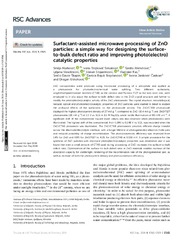Приказ основних података о документу
Surfactant-assisted microwave processing of ZnO particles: a simple way for designing the surface-to-bulk defect ratio and improving photo(electro)catalytic properties
| dc.creator | Marković, Smilja | |
| dc.creator | Stojković-Simatović, Ivana | |
| dc.creator | Ahmetović, Sanita | |
| dc.creator | Veselinović, Ljiljana | |
| dc.creator | Stojadinović, Stevan | |
| dc.creator | Rac, Vladislav | |
| dc.creator | Škapin, Srečo Davor | |
| dc.creator | Bajuk-Bogdanović, Danica | |
| dc.creator | Janković-Častvan, Ivona | |
| dc.creator | Uskoković, Dragan | |
| dc.date.accessioned | 2021-03-10T14:05:54Z | |
| dc.date.available | 2021-03-10T14:05:54Z | |
| dc.date.issued | 2019 | |
| dc.identifier.issn | 2046-2069 | |
| dc.identifier.uri | http://TechnoRep.tmf.bg.ac.rs/handle/123456789/4235 | |
| dc.description.abstract | ZnO nanopowders were produced using microwave processing of a precipitate and applied as a photoanode for photoelectrochemical water splitting. Two different surfactants, cetyltrimethylammonium bromide (CTAB) as the cationic and Pluronic F127 as the non-ionic one, were employed to in situ adjust the surface-to-bulk defect ratio in the ZnO crystal structure and further to modify the photo(electro)catalytic activity of the ZnO photoanode. The crystal structure, morphological, textural, optical and photo(electro)catalytic properties of ZnO particles were studied in detail to explain the profound effects of the surfactants on the photoanode activity. The ZnO/CTAB photoanode displayed the highest photocurrent density of 27 mA g(-1), compared to ZnO (10.4 mA g(-1)) and ZnO/F127 photoanodes (20 mA g(-1)) at 1.5 V vs. SCE in 0.1 M Na2SO4 under visible illumination of 90 mW cm(-2). A significant shift of the overpotential toward lower values was also observed when photoanodes were illuminated. The highest shift of the overpotential, from 1.296 to 0.248 V vs. SCE, was recorded when the ZnO/CTAB photanode was illuminated. The ZnO/CTAB photoanode provides efficient charge transfer across the electrode/electrolyte interface, with a longer lifetime of photogenerated electron-hole pairs and reduced possibility of charge recombination. The photoconversion efficiency was improved from 1.4% for ZnO and 0.9% for ZnO/F127 to 4.2% for ZnO/CTAB at 0.510 mV. A simple procedure for the synthesis of ZnO particles with improved photo(electro)catalytic properties was established and it was found that even a small amount of CTAB used during processing of ZnO increases the surface-to-bulk defect ratio. Optimization of the surface-to-bulk defect ratio in ZnO materials enables increase of the absorption capacity for visible light, rendering of the recombination rate of the photogenerated pair, as well as increase of both the photocurrent density and photoconversion efficiency. | en |
| dc.publisher | Royal Soc Chemistry, Cambridge | |
| dc.relation | info:eu-repo/grantAgreement/MESTD/Integrated and Interdisciplinary Research (IIR or III)/45004/RS// | |
| dc.relation | Republic of Serbia "Nanostructured and mesoporous functional materials with enhanced solar light driven photocatalytic activity" for 2018-2019 | |
| dc.relation | Republic of Slovenia "Nanostructured and mesoporous functional materials with enhanced solar light driven photocatalytic activity" for 2018-2019 | |
| dc.rights | openAccess | |
| dc.rights.uri | https://creativecommons.org/licenses/by-nc/4.0/ | |
| dc.source | RSC Advances | |
| dc.title | Surfactant-assisted microwave processing of ZnO particles: a simple way for designing the surface-to-bulk defect ratio and improving photo(electro)catalytic properties | en |
| dc.type | article | |
| dc.rights.license | BY-NC | |
| dc.citation.epage | 17178 | |
| dc.citation.issue | 30 | |
| dc.citation.other | 9(30): 17165-17178 | |
| dc.citation.rank | M22 | |
| dc.citation.spage | 17165 | |
| dc.citation.volume | 9 | |
| dc.identifier.doi | 10.1039/c9ra02553g | |
| dc.identifier.fulltext | http://TechnoRep.tmf.bg.ac.rs/bitstream/id/1918/4232.pdf | |
| dc.identifier.scopus | 2-s2.0-85067467088 | |
| dc.identifier.wos | 000471912700025 | |
| dc.type.version | publishedVersion |

